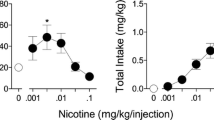Abstract
A total 31 psychoactive drugs were offered to groups of naive rats for IV self-administration and an injection rate greater than that for rats offered only saline indicated reinforcement. Two protocols were used: in the first, rats were offered drug at a selected dose for 5 days, then the dose was reduced by 1 log unit (to 0.1 the original dose) for an additional 4 days; in the second, rats were offered saline for 3 days as a ‘prescreen’ to eliminate rats with high or low operant-injection rates. Drug was offered to acceptable rats for 5 days, then the dose was reduced 0.5 log unit (to 0.32 the original dose) for 5 more days. A scoring system, based upon the injection rates during the last 3 days of each period, describes the reinforcing action. Scores were dose-related. Tests on both protocols gave similar results. Data from monkey studies have been reported for 27 of the drugs tested. Of these drugs, 18 were reinforcers and six were nonreinforcers in both species, nalorphine and ethylketazocine were reinforcers only in rats, and ethanol was a reinforcer only in monkeys.
Similar content being viewed by others
References
Box GEP, Jenkins GM (1976) Time series analysis. Holder-Day, San Francisco, pp 278–279
Deneau G, Yanagita T, Seevers MH (1969) Self-administration of psychoactive substances by the monkey. Psychopharmacologia 16:30–48
Griffiths RR, Balster RL (1979) Opioids: Similarity between evaluation of subjective effects and animal self-administration results. Clin Pharmacol Ther 25:611–617
Griffiths RR, Bigelow GE, Henningfield JE (1980) Similarities in animal and human drug-taking behavior. In: Mello NK (ed) Advances in substance abuse, vol 1. JAI, Greenwich CN, pp 1–90
Griffiths RR, Brady JV, Bradford LD (1979) Predicting the abuse liability of drugs with animal drug self-administration procedures: Psychomotor stimulants and hallucinogens. In: Thompson T, Dews PB (eds) Advances in behavioral pharmacology, vol 2. Academic, New York, pp 163–208
Johanson CE, Balster RL (1978) A summary of the results of a drug self-administration study using substitution procedures in rhesus monkeys. Bull Narc 20:43–54
Morrison DF (1967) Multivariate statistical methods. McGraw Hill, San Francisco, pp 121–127
van Ree JM (1979) Reinforcing stimulus properties of drugs. Neuropharmacology 18:963–969
van Ree JM, Slangen JL, deWied D (1978) Intravenous self-administration of drugs in rats. J Pharmacol Exp Ther 204:547–557
Schuster CR, Thompson T (1969) Self-administration of and behavioral dependence on drug. Annu Rev Pharmacol 9:483–502
Shapiro RS, Wilk MB (1965) An analysis of variance test for normality (complete samples). Biometrika 52:591–611
Sinden JD, Le Magnen J (1982) Parameters of low-dose ethanol intravenous self-administration in the rat. Pharmacol Biochem Behav 16:181–193
Smith SG, Davis WM (1974) Intravenous alcohol self-administration in the rat. Pharmacol Res Commun 6:397–402
Thompson T, Unna KR (eds) (1977) Predicting dependence liability of stimulant and depressant drugs. University Park Press, Baltimore London Tokyo
Weeks JR (1962) Experimental morphine addiction: Method for automatic intravenous injections in unrestrained rats. Science 138:143–144
Weeks JR (1972) Long-term intravenous infusion. In: Myers RD (ed) Methods in psychobiology, vol 2. Academic, London, pp 155–168
Weeks JR (1977) The pneumatic syringe: A simple apparatus for self-administration of drugs by rats. Pharmacol Biochem Behav 7:559–562
Weeks JR (1979) A method for administration of prolonged intravenous infusion of prostacyclin (PGI2) to unanesthetized rats. Prostaglandins 17:495–499
Weeks JR (1981) An improved pneumatic syringe for self-administration of drugs by rats. Pharmacol Biochem Behav 14:573–574
Weeks, JR, Collins RJ (1976) Changes in morphine self-administration in rats induced by prostaglandin E1 and naloxone. Prostaglandins 12:11–19
Weeks JR, Collins RJ (1979) Dose and physical dependence as factors in the self-administration of morphine by rats. Psychopharmacology 65:171–177
Woods JH, Smith CB, Medzihradsky F, Swain HH (1979) Preclinical testing of new analgesic drugs. In: Beers RE, Bassett EG (eds) Mechanisms of pain and analgesic compounds. Raven, New York, pp 429–445
Yanagita T (1977) Brief review of the use of self-administration techniques for predicting drug-dependence potential. In: Thompson T, Unna KR (eds) Predicting dependence liability of stimulant and depressant drugs. University Park Press, Baltimore London Tokyo, pp 231–242
Author information
Authors and Affiliations
Rights and permissions
About this article
Cite this article
Collins, R.J., Weeks, J.R., Cooper, M.M. et al. Prediction of abuse liability of drugs using IV self-administration by rats. Psychopharmacology 82, 6–13 (1983). https://doi.org/10.1007/BF00426372
Received:
Accepted:
Issue Date:
DOI: https://doi.org/10.1007/BF00426372




